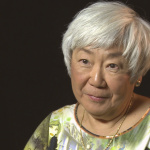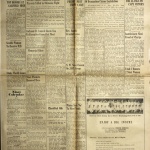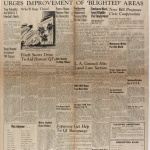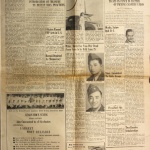Shigeo Yoshida
| Name | Shigeo Yoshida |
|---|---|
| Born | 1907 |
| Died | 1986 |
| Birth Location | Hilo, HI |
| Generational Identifier |
Largely unrecognized in history, Shigeo Yoshida (1907–86) played the most central role during World War II among Nisei in preventing the mass removal and incarceration of Japanese Americans in Hawai'i and also in maximizing Japanese American participation in the war effort. He was integrally involved in organizing the Varsity Victory Volunteers labor battalion, the Army's deployment of the Japanese American 100th Battalion , and mobilizing the 442nd Regimental Combat Team .
Early Life
Yoshida was born in the sugar industry town of Hilo, Hawai'i, in 1907, the fourth of eight children of Naoko and Ichi Yoshida. At a time when most Japanese arrived as single males, the Yoshidas had immigrated from Kumamoto Prefecture as a couple. As a result, Shigeo Yoshida was part of a vanguard in Hawai'i who acquired a Western education and cross-cultural leadership skills well before the onset of World War II.
He was a star student at Hilo High School. He edited the school yearbook and, most memorably, was the champion high school debater in the Territory of Hawai'i. Moving from the Big Island to Honolulu, he enrolled in the University of Hawaii (UH) as one of only several hundred students. He again dominated student debate. In the process he came to the attention of the founding chairman of the UH regents, Charles Reed Hemenway, a business executive with a passion for community-building. Hemenway opened not only his home but his thinking to Yoshida, as well as to many other nonwhite students, including the charismatic Hung Wai Ching , who was to become Yoshida's collaborator in the home front war effort. As a mark of Yoshida's high regard for Hemenway, he eventually gave the name Charles to one of his sons and Reed to his second.
Prewar Activism
In Yoshida's professional life during the 1930s, he was quickly recognized for his skills as a classroom teacher and a public school administrator. He was exposed to the Pan-Pacific movement and also participated in the Congregational Church of the Crossroads, which is regarded as the first consciously interracial church in Hawai'i. He also was active in the Hawaiian Japanese Civic Association, a leadership development group made up largely of Nisei.
In 1937, Yoshida famously testified to a visiting congressional committee on behalf of statehood for Hawaii. Along with the venerable attorney Masaji Marumoto , Yoshida was the first Japanese American to address Congress on behalf of statehood for Hawaii. Yoshida said that while he abhorred war, he would welcome the opportunity to fight for America as a means of putting to rest the question of Nisei loyalty.
In August 1939, he was set up by Hemenway to engage in dialogue with the new FBI agent in charge, Robert L. Shivers , who was reanalyzing the probable loyalty of the Japanese community to America in the event of war with Japan. From this beginning, Yoshida became a key participant, along with Hung Wai Ching, in working across ethnic lines to prepare Hawai'i socially and psychologically for the shock of a Pacific war. [1]
In addition to being an effective speaker Yoshida was a clear and prolific writer, grandly defining the interracial work group as the Council for Interracial Unity. Yoshida, Ching, and several others were headed for a Sunday breakfast at the home of the FBI's Shivers when they received word that Japan was bombing the American Pacific fleet. [2]
Wartime Leader
Having thought deeply about the likelihood of war, Yoshida responded by instantly mobilizing himself. Substantially as a result of Hemenway's intervention with the martial law government, he became one of three persons organized into a Morale Section that functioned as a liaison, and adviser, to the army. The others were Ching and another YMCA executive, Charles Loomis. [3] As the only Japanese American in this trio, Yoshida was the single person of Japanese ancestry best situated to influence the course of the martial law government in Hawai'i . [4]
The executive officer of the martial law government singled out Yoshida in particular for his acute intelligence and overall trustworthiness. In the heat of the moment, the new martial law governor, Gen. Delos Emmons , made a decision—without consulting Washington—to announce that there was to be no mass removal or incarceration of Japanese Americans in Hawai'i. He was edged forward to take this unauthorized step through his contacts with his own intelligence officers, Shivers, Yoshida, other Nisei advisers and the members of the Council for Interracial Unity. Army intelligence asked Ching to draft Emmons' radio address but Ching passed this task on to Yoshida. [5]
Yoshida quickly mapped a strategy of actively cooperating with the government and displaying patriotism as the best means of preventing or minimizing internment. He referred incessantly to the creation of a new and more democratic society in the postwar. His mantra was, "How we get along during the war will determine how we get along when the war is over."
In tandem with Ching, he organized every ethnic group on every major island. The effect of this effort was to sanction the widely varied niches of Japanese community life to organize and become involved in the war effort. It served to counter the waves of panic, depression and withdrawal that periodically swept through the population. As the most crucial part of this effort, Yoshida led the way in organizing an all-Nisei Emergency Service Committee (ESC) on O'ahu, then Kaua'i, Maui and Hawai'i Island. [6]
Confidence and trust grew between the martial law government and the Hawai'i community. This was a major factor in Emmons' decision to send the thirteen hundred men of the 100th Battalion to the U.S. mainland in June 1942 for combat training. When President Roosevelt called in January 1943 for development of the 442nd RCT, the ESC network led the campaign that resulted in an overflow of nearly ten thousand volunteers, with the result that the 442nd trained as a full-strength combat team.
After the 442nd formed, Yoshida returned to developing a broad system of interracial communication and shared leadership. He frequently confronted resistance from the Caucasian elite to dealing with nonwhites on an equal basis. Nonetheless, he, Ching and Loomis insisted on, and eventually achieved, the formation of a Caucasian leadership group that functioned in tandem and then partnership with the ESC.
Yoshida systematically integrated his interracial work and his preparation of the Japanese community for a postwar multiracial society. He led three territory-wide conferences of the Emergency Service Committee focusing on a new Hawai'i in the postwar. As part of this effort, he developed a consensus for dissolution of the ESC at war's end.
Thereafter he returned to the public school system, where he rejected promotion and served at the community level as a school principal. His contributions during the war were little discussed and little remarked. He died in 1986 at age 78.
For More Information
The First Battle: The Battle for Equality in War-Time Hawaii . Written, produced, and directed by Tom Coffman, 2007. 60 min.
Footnotes
- ↑ Clark, Blake, Hawaii the 49th State, Doubleday & Co., 1947, p. 118-119, is an early account of the 1939 interracial conversations. To my knowledge, the most authentic account is a memorandum by Yoshida, "The Council for Interracial Unity," written a few days after the Pearl Harbor bombing. It is located at the University of Hawaii Research Library in RASRL Box 1, Morale Section file. These are unprocessed files that are now being analyzed in detail.
- ↑ Interviews, Hung Wai Ching and Shizue "Sue" Isonaga, www.thefirstbattle.com.
- ↑ Charles Loomis came to Hawaii as a YMCA executive. He moved into a more expansive role in the late 1920s and 1930s as the secretary of the Institute for Pacific Relations, which then was headquartered in Hawaii and supported financially by key figures in the Hawaii oligarchy.
- ↑ I arrived at this conclusion slowly and after examining numerous sources. It derives from locating the three-member Morale Section as the core interface between the civilian community and the military government. Once this is understood, we can clearly see Yoshida's role in organizing, activating, licensing, etc. the Emergency Service Committee and its major role, in turn, with development of the Japanese American military units. The much better known figures in this story were Marumoto, a distinguished attorney and close personal friend of Shivers, who was the first chairperson of the ESC; and John A. Burns, head of the Police Contact Group, which worked in tandem with the ESC. In the postwar Marumoto was twice named to the Hawaii Supreme Court and Burns became the central and legendary figure in the rise of the Hawaii Democratic Party.
- ↑ Hung Wai Ching, interview for the video documentary "The First Battle." See www.thefirstbattle.com.
- ↑ Yoshida wrote in his personal notes of May 5, 1942, "Had a conference with Rev. Paul L. Denise (Loomis and Ching present) about the Kauai situation," Yoshida wrote in his notes. "Situation not so good. Hope we can go there to get something done." For subsequent activity see UH/RASRL Box 1, Kauai Morale Committee, also Maui. On May 23, 1942, Yoshida, Ching, Loomis, and Masaji Marumoto arrived on Kauai to organize the Kauai Morale Committee. Maui and the Big Island followed.
Last updated Dec. 12, 2023, 2:16 a.m..







